If you want to build a bigger, stronger back without putting stress on your spine, the close-grip lat pulldown deserves a spot in your routine.
Like other lat pulldown variations, it’s excellent for training your lats, traps, and rhomboids. What sets the close-grip version apart is it emphasizes your rear delts, making it particularly effective for building your upper back.
In this article, you’ll learn how to perform the close-grip pulldown with perfect form, discover which muscles it works, understand how to avoid common mistakes, and more.
Want to know exactly how you should train to reach your fitness goals? Take our 60-second quiz and learn exactly how often you should train, what exercises and how many sets and reps you should do, and more.
Key Takeaways
- The close-grip lat pulldown is great for building back mass and strength without stressing your spine.
- It primarily trains your lats, traps, rhomboids, and rear delts, making it ideal for mid- and upper-back development.
- Unlike some other “vertical pulling exercises,” the close-grip pulldown is easy to learn and highly scalable, so it’s a solid option for beginners.
- To maximize results, avoid using momentum, pulling too low, or relying too much on your biceps.
- The best close-grip lat pulldown alternatives are the one-arm lat pulldown, neutral-grip pull-up, lat pulldown, cable row, and one-arm dumbbell row.
Table of Contents
+
How to Do the Close-Grip Lat Pulldown
Here how to do the close-grip lat pulldown with proper form:
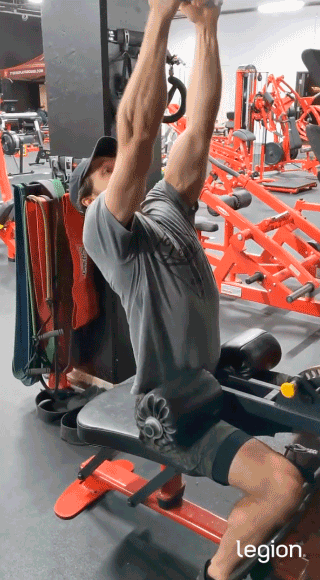
1. Set up
Attach a V-bar to the lat pulldown machine pulley. Sit on the seat and adjust the knee pad so that it locks your lower body in place, then slide your thighs out, stand up, and grab the V-bar with both hands.
While keeping your grip on the handle and your arms straight, sit down, allowing your body weight to pull the handle down with you. Nudge your thighs under the knee pads and plant your feet on the floor.
2. Pull
Raise your chest and slightly arch your lower back to help engage your lats.
Without whipping your torso backward, pull the handle toward your chest until it’s underneath your chin. As you pull the handle down, squeeze your shoulder blades together and tuck them downward.
3. Ascend
Reverse the movement and return to the starting position
Close-Grip Lat Pulldown: Muscles Worked
The close-grip lat pulldown works the:
- Latissimus dorsi (lats)
- Trapezius (traps)
- Rhomboids
- Infraspinatus
- Teres major and minor
- Posterior deltoids (rear delts)
- Erector spinae
- Biceps
- Brachialis
- Brachioradialis
Here’s how these muscles look on your body:
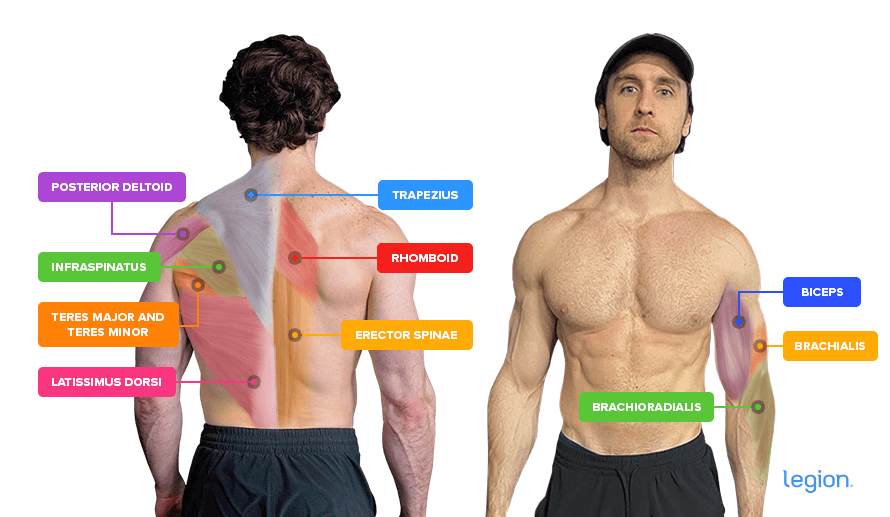
Benefits of the Close-Grip Lat Pulldown
Let’s explore some of the key advantages of the close-grip lat pulldown.
Full Back Training
The close-grip lat pulldown is an excellent exercise for training your entire back, especially the lats, rhomboids, traps, and rear deltoids. It also trains your biceps, shoulders, forearms, triceps, pecs, and abs to a lesser degree, making it a top-tier exercise for all-around upper-body size and strength
Easy to Learn
The close-grip pulldown requires less technique than other “vertical pulling exercises” like pull-ups or chin-ups. Since it’s a machine exercise, it’s also more stable, doesn’t demand much coordination or balance, and lets you start with lighter weights and build strength gradually, making it ideal for beginners.
Reduced Lower Back Stress
Unlike exercises such as bent-over rows, which stress your spine while bent over, the close-grip lat pulldown allows you to maintain an upright posture, reducing lower back discomfort.
Improved Posture
The narrow-grip lat pulldown improves your posture by strengthening the muscles that keep your shoulders back, which can help prevent excessive upper back rounding.
Common Close-Grip Lat Pulldown Mistakes
While the close-grip lat pulldown is an effective exercise, it’s crucial to be aware of common mistakes that can hinder your progress and increase the risk of injury. Here are some common blunders to avoid:
Using Momentum
Generating momentum by “whipping” your upper body backward as you pull the weight lowers back engagement and shifts the emphasis onto other muscle groups, which is a bad thing if developing your back is your top priority.
Avoid this by keeping your back stationary and maintaining upper-body tightness throughout the range of motion.
Pulling Too Low
Bringing the bar below your upper chest can strain your shoulder joint and reduce the exercise’s effectiveness. Stick to the correct range of motion, lowering the bar to beneath your chin or so that it touches your upper pecs. This engages your back muscles properly and prevents shoulder discomfort.
Pulling with Your Biceps
It’s easy to rely too much on your biceps instead of your back when performing the close-grip pulldown. However, doing so robs you of muscle and strength gain in the target muscles.
To minimize biceps engagement, imagine pulling your elbows into the floor. This maximizes how much your lats contribute while lessening biceps involvement.
Sets and Reps for the Close-Grip Lat Pulldown
The close-grip pulldown involves several major muscle groups simultaneously, so you can use heavier weights without compromising safety, provided you use good form.
Doing 3 sets of 4-to-6 or 6-to-8 reps works well for most men, whereas 3 sets of 6-to-8 or 8-to-10 reps is more fitting for women.
The Best Close-Grip Lat Pulldown Alternatives
Close-grip lat pulldown alternatives can add variety to your workout routine and target the muscles of the back in different ways. Here are five of the best:
1. One-Arm Lat Pulldown
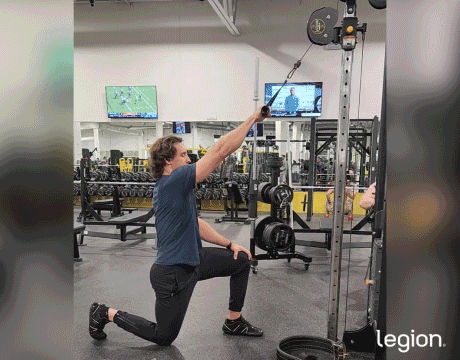
The one-arm lat pulldown is a great variation for finding and fixing muscle imbalances because it allows you to focus on one side of the body at a time.
To perform the one-arm lat pulldown, attach a D-handle to the top pulley of a cable machine, grab the handle and adopt a half-kneeling stance, then pull the handle to your chest.
This exercise also engages the core muscles, particularly the obliques, as they must work hard to stabilize your the body.
2. Neutral-Grip Pull-up
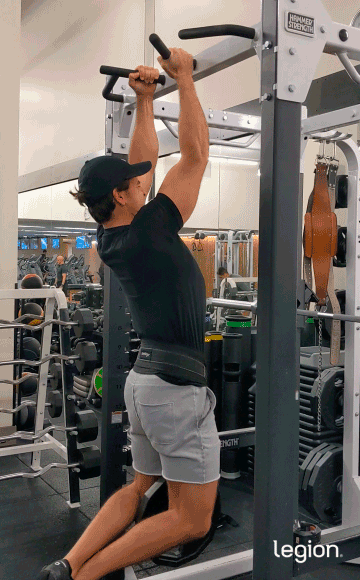
Neutral-grip pull-ups are an excellent alternative to the close-grip lat pulldown, targeting the same muscles but without the need for a lat pulldown machine. You can perform this variation using a set of parallel bars or a neutral-grip pull-up bar.
READ MORE: How to Do the Neutral-Grip Pull-up for Back Mass & Width
3. Lat Pulldown
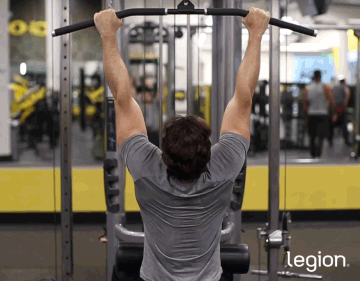
The regular lat pulldown trains your back similarly to the close-grip lat pulldown, though it may be slightly better at training the lats and less effective at targeting the rear delts.
READ MORE: How to Do the Lat Pulldown: Form, Benefits, & Variations
4. Cable Row
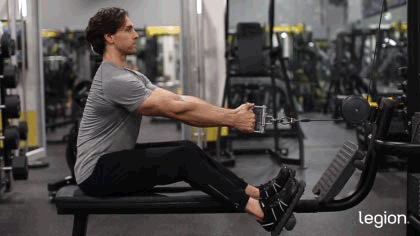
The cable row is an excellent alternative to the narrow-grip lat pulldown that involves using a neutral grip to pull a weight horizontally toward your midsection while keeping your elbows close to your sides. Similarly to the close-grip pulldown, the cable row trains your mid back to a high degree, especially your lats.
READ MORE: How to Do the Seated Cable Row: Muscles Worked, Form, and Alternatives
5. One-Arm Dumbbell Row
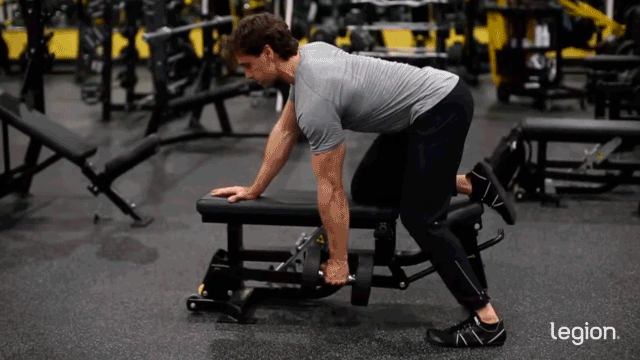
The one-arm dumbbell row is another great alternative to the close-grip lat pulldown, training all the muscles of the middle back, particularly the lats, traps, and rhomboids. To perform the exercise, hold a dumbbell in one hand, place the opposite knee and hand on a bench for support, and row the dumbbell to your side while keeping your back straight.
A significant advantage of the one-arm dumbbell row is that it requires little equipment, making it a useful alternative for those who don’t have access to a lat pulldown machine.
READ MORE: How to Do the Bent-Over Dumbbell Row
FAQ #1: Close-grip vs. Wide-grip lat pulldown: What’s the difference?
The wide grip pulldown is a little better at training your lats, and the close-grip pulldown is marginally better at training your rear delts. The close-grip variation also trains the pecs and triceps more than the wide grip version, though neither is a “chest” or “triceps” exercise.
FAQ #2: Which of all the different lat pulldown grips is best?
There’s no such thing as the “best” grip for the lat pulldown. The best solution for most people is to periodically experiment with grip widths and orientations.
Doing so likely causes more balanced and complete growth than using just one or two grips, and it may help you avoid repetitive strain injuries, which can occur when you do the same exercise for long periods.
FAQ #3: Is the underhand close-grip lat pulldown good?
Yes, the underhand close-grip lat pulldown is a solid variation of the exercise, especially if you want to emphasize your biceps. That said, some people find it can put strain on their wrists. If that’s the case, you may want to stick with a different lat pulldown grip.
To perform the underhand close-grip lat pulldown, grip a straight bar 4-to-8 inches apart, palms facing you.
Scientific References +
- Signorile, Joseph F., et al. “A Comparative Electromyographical Investigation of Muscle Utilization Patterns Using Various Hand Positions during the Lat Pull-Down.” Journal of Strength and Conditioning Research, vol. 16, no. 4, 1 Nov. 2002, pp. 539–546, pubmed.ncbi.nlm.nih.gov/12423182/. Accessed 2 Aug. 2021.
- Handa, Tohru , et al. Comparative Electromyographical Investigation of the Biceps Brachii, Latissimus Dorsi, and Trapezius Muscles during Five Pull Exercises. Apr. 2005, https://doi.org/10.7600/jspfsm.54.159.
- Barakat, Christopher, et al. “The Effects of Varying Glenohumeral Joint Angle on Acute Volume Load, Muscle Activation, Swelling, and Echo-Intensity on the Biceps Brachii in Resistance-Trained Individuals.” Sports, vol. 7, no. 9, 4 Sept. 2019, p. 204, https://doi.org/10.3390/sports7090204.
- Costa, Bruna Daniella de Vasconcelos, et al. “Does Performing Different Resistance Exercises for the Same Muscle Group Induce Non-Homogeneous Hypertrophy?” International Journal of Sports Medicine, vol. 42, no. 09, 13 Jan. 2021, pp. 803–811, https://doi.org/10.1055/a-1308-3674.










